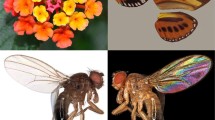Summary
Quantitative TEM refutes the hypothesis of multivesicular body formation at dawn via the degradation of photoreceptor. No significant relationship exists between multivesicular bodies and rhabdom diameter or between multivesicular bodies and coated vesicles. The density of multivesicular bodies is related to the vesicle-producing Golgi bodies. A new theory concerning the formation and possible function of multivesicular bodies is discussed.
Similar content being viewed by others
References
Blest AD, Stowe S, Price GD (1980) The sources of acid hydrolases for photoreceptor membrane degradation in a grapsid crab. Cell Tissue Res 205:229–244
Debaisieux P (1942) Accomodation à la lumière des yeux de Decapodes. Ann Soc R Zool Belg 73:51–53
Debaisieux P (1944) Les yeux des Crustacés. La Cellule 50:1–122
Eguchi E, Waterman TH (1967) Changes in retinal fine structure in the crab Libinia by light and dark adaptation. Z Zellforsch 79:209–229
Eguchi E, Waterman TH (1976) Freeze-etch and histochemical evidence for cycling in crayfish photoreceptor membrane. Cell Tissue Res 169:419–434
Hafner GS, Bok D (1977) The distribution of H-leucine labelled protein in the retinula cells of crayfish. J Comp Neurol 174:397–416
Hafner GS, Hammond-Soltis G, Tokarski T (1980) Diurnal changes of lysosome-related bodies in the crayfish photoreceptor cells. Cell Tissue Res 206:319–332
Piekos WB (1986) The role of reflecting pigment cells in the turnover of crayfish photoreceptors. Cell Tissue Res 244:645–654
Piekos WB, Waterman TH (1983) Nocturnal rhabdom cycling and retinal hemocyte functions in crayfish (Procambarus) compound eyes. I. Light microscopy. J Exp Zool 225:209–217
Waterman TH, Piekos WB (1981) Light and time correlated migration of invasive hemocytes in the crayfish compound eye. J Exp Zool 217:1–14
Waterman TH, Piekos WB (1983) Nocturnal rhabdom cycling and retinal hemocyte functions in crayfish (Procambarus) compound eyes. II. Transmission electron microscopy and acid phosphatase localizations. J Exp Zool 225:219–231
White RH (1964) The effect of light upon the ultrastructure of the mosquito eye. Am Zool 4:433
White RH (1968) The effect of light and light deprivation upon the structure of the larval mosquito eye. III. Multivesicular bodies and protein uptake. J Exp Zool 169:261–268
Author information
Authors and Affiliations
Rights and permissions
About this article
Cite this article
Piekos, W.B. Multivesicular body formation and function in the light-adapted crayfish retina: a new interpretation. Cell Tissue Res. 249, 541–546 (1987). https://doi.org/10.1007/BF00217325
Accepted:
Issue Date:
DOI: https://doi.org/10.1007/BF00217325




